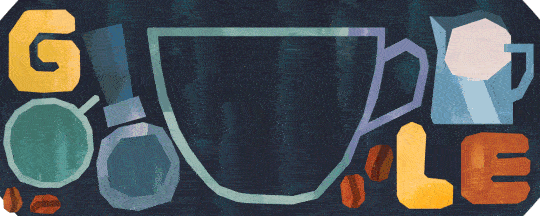To stay or to leave? Today’s Google animated Doodle honors the flat white, a popular coffee drink made with steamed milk and espresso. The flat white, a well-liked espresso-based beverage that originated in Australia and New Zealand, is celebrated in this animated Doodle. The Oxford English Dictionary added flat white on March 11, 2011. Here are some interesting and amazing fun facts about flat white.
25 Interesting Facts about Flat White
- Espresso and microfoam—steamed milk with tiny, fine bubbles and a glossy or velvety consistency—combine to make a flat white, coffee beverage. Compared to a cappuccino, it typically has a thinner layer of microfoam and a higher espresso-to-milk ratio. Although its exact origins are unknown, several café owners in Australia and New Zealand assert that they invented the flat white.
- According to Anette Moldvaer, a flat white is made up of roughly 130 ml (4 fl oz) of steamed milk with a 5 mm (0.25 inch) layer of microform, and a double espresso (50 ml/1.5 fl oz).
- A survey of industry observers revealed that a typical cappuccino has a much thicker layer of foam than a flat white, which has a much thinner layer of microfoam—hence the word “flat” in flat white.
- An espresso-based coffee beverage is called a flat white. To make it, add microfoam—steamed milk with tiny, fine bubbles and a velvety, glossy consistency—to one or two shots of espresso.
- However, different areas and cafés have different flat white recipes. A flat white is traditionally served in Australia in a ceramic mug that holds 200 ml, or 7.0 imp fl oz., which is the same capacity as a latte glass.
- That being said, some Australian cafés will add more foam to a latte, while others might pour a slightly shorter flat white. A tulip-shaped cup (165 ml, 5.8 imp fl oz) is the most typical serving vessel for New Zealand flat whites.
- The ratio of milk to coffee and the consistency of the milk as a result of heating methods are the two widely acknowledged distinctions between lattes and flat whites in both Australia and New Zealand.
- While the exact origin of the flat white is unknown, coffee historian Ian Bersten believes it most likely started in England in the 1950s.
- In the 1980s, references to the beverage were made in Italy as well as Australia. Miller’s Treat, a Sydney café, was mentioned as having “flat white coffee” in a May 1983 review. In April 1984, an additional Sydney newspaper article parodied the popularity of caffè latte by joking that “café latte translates as flat white.”
- In 1985, Alan Preston added the drink to his permanent menu at Moors Espresso Bar in Sydney. Preston claimed to have brought the concept to Sydney from his home state of Queensland, where “White Coffee – flat” was a common offering at cafés during the 1960s and 1970s.
- Additional documented references include the January 1985 posting of a “flat white only” sign by the Parliament House cafeteria in Canberra in response to a seasonal issue with milk cows that prevented the formation of milk froth.
- The flat white’s origins, however, are controversial since New Zealand also claims to be the country of origin. Two claims from New Zealand are made: one from Derek Townsend and Darrell Ahlers of Cafe DKD in Auckland, as a substitute for the Italian latte; and another from Wellington, following a “failed cappuccino” at Bar Bodega on Willis St. in 1989.
- The author of Coffee Houses of Wellington from 1939 to 1979, Craig Miller, says he made a flat white in Auckland in the mid-1980s.
- The flat white shares characteristics with the traditional Italian cappuccino, which consists of a single espresso served in a 150–160 ml (5.3–5.6 imp fl oz) cup with microfoam. In contrast, there is less foam and a larger percentage of coffee in the flat white.
- Compared to a caffè latte, a flat white typically has a thinner layer of froth and a higher espresso-to-steamed milk ratio.
- According to popular belief, the drink was initially offered in Australia and New Zealand in the 1980s when it appeared on menus in Sydney and Auckland at about the same time.
- A flat white is traditionally served in a ceramic cup and consists of an espresso shot covered in a thin layer of microform and steamed milk.
- Coffee enthusiasts who prefer less foam like flat whites because they are “flatter” than a cappuccino or latte. Many cafés in Australia and New Zealand are frequented by baristas who use their pouring technique to create beautiful artwork, showcasing their skills.
- Over time, coffee culture has evolved significantly, and with it, the methods for preparing flat whites. Originally made with whole milk, Australians and New Zealanders frequently order it with plant-based milk these days—oat milk is becoming a popular choice!
- By 2005, the coffee style had been exported outside of Australia and New Zealand to the United Kingdom, where it was being sold in Starbucks franchises by 2010.
- By 2013, Hugh Jackman co-owned one of the Australian cafés in New York City where the flat white was served, and he was an endorser of the product.
- Large coffee shop chains like Starbucks, Costa Coffee, Caffè Nero, and Pret a Manger introduced flat whites to their menus as the beverage gained popularity worldwide. On January 6, 2015, Starbucks introduced the flat white to American locations.
- The internet, media, and creative industries in London have been collectively referred to as the “flat white economy” in the United Kingdom.
- Over time, the flat white has become a global favorite and staple in many countries. Whatever its origins, coffee is universally loved by those who need a pick-me-up in the morning or the afternoon.
- On March 11, 2024, Google featured a Google Doodle on its homepage to celebrate the Flat White.
